Employees are constantly seeking ways to enhance their skills and advance their careers, while employers strive to retain top talent and maintain a competitive edge. Enter the Individual Development Plan (IDP) – a strategic tool designed to bridge the gap between ambition and achievement. This comprehensive guide will delve into the significance of IDPs, provide examples to inspire your plan and offer step-by-step instructions on creating a tailored roadmap for success.
What is an Individual Development Plan Example?
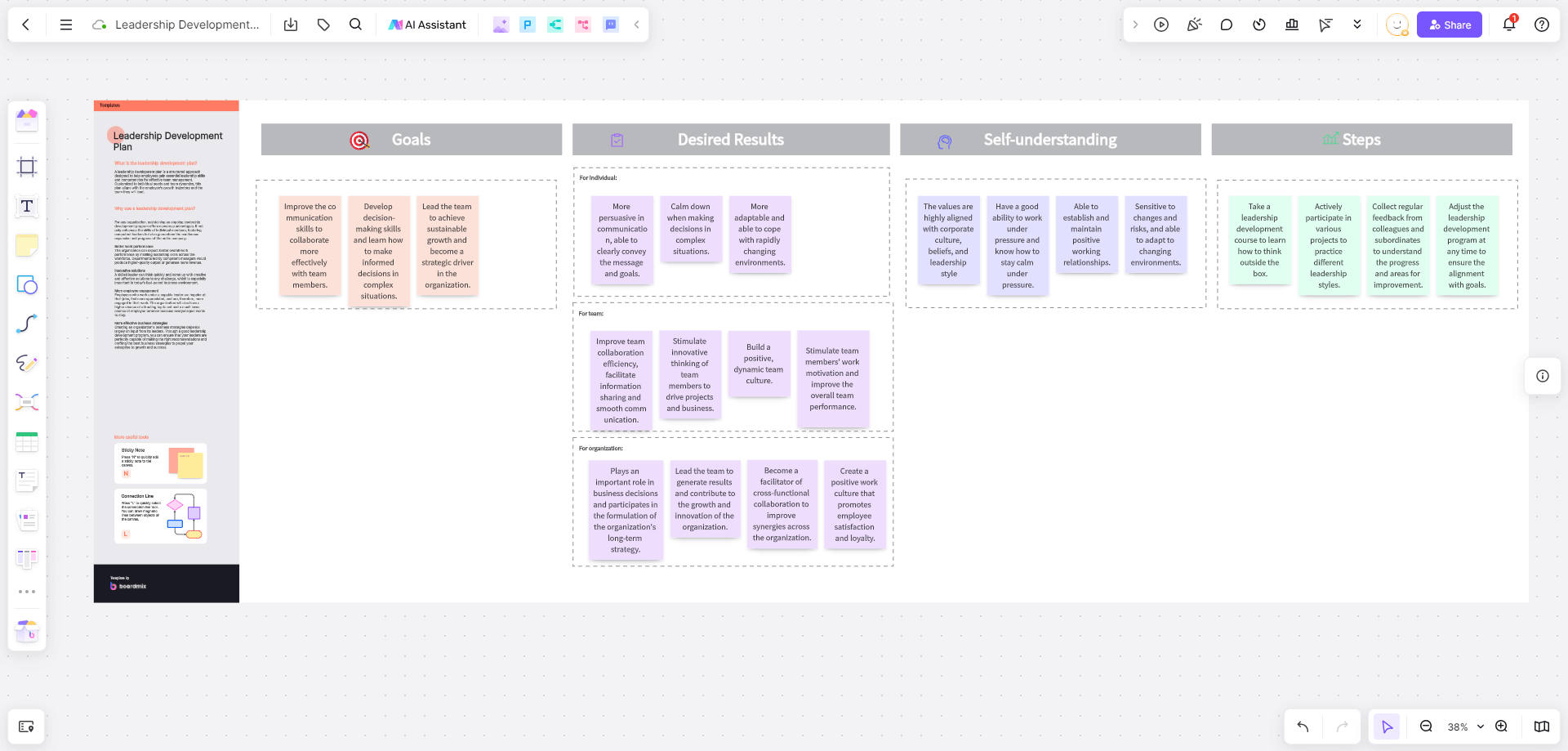
An Individual Development Plan (IDP) is a structured framework used to identify and outline the skills, knowledge, and experiences an employee needs to achieve their professional goals. These plans are typically created collaboratively between an employee and their supervisor and serve as a roadmap for personal and professional development. An example of an IDP might include specific goals such as acquiring new technical skills, improving leadership capabilities, or expanding industry knowledge, along with actionable steps and a timeline for achieving these objectives.
For instance, a mid-level manager aspiring to move into a senior leadership role might have an IDP that includes goals like completing a leadership training program, gaining experience in strategic planning, and building a network of industry contacts. The plan would detail specific actions to achieve these goals, such as attending relevant workshops, seeking mentorship, and participating in cross-departmental projects.
Why Individual Development Plan is Important for employee growth?
The importance of Individual Development Plans cannot be overstated, particularly in today's dynamic job market where employee retention and satisfaction are critical to organizational success. IDPs play a pivotal role in promoting employee growth for several reasons:
Reducing Employee Turnover: High employee turnover can be costly and disruptive. By providing development opportunities through IDPs, companies can retain top talent. According to a report by the Work Institute, 22% of employees leave their jobs for career development reasons. Offering clear development paths can mitigate this risk.
Enhancing Employee Engagement: When employees have a clear path for development, they are more likely to feel engaged and motivated. Knowing that the organization invests in its growth can lead to higher job satisfaction and loyalty.
Aligning Individual Goals with Organizational Objectives: IDPs ensure that employee development is aligned with the broader goals of the organization. This alignment helps employees see how their personal growth contributes to the company's success, fostering a sense of purpose and belonging.
Adapting to Market Needs: In a rapidly changing market, the skills and knowledge required can shift quickly. IDPs help employees stay current and adaptable, ensuring that the organization remains competitive. For example, with the rise of digital transformation, employees may need to upskill in areas like data analytics or cybersecurity.
10 Free Individual Development Plan Examples
1. Technical Skills Development Plan

Goal: Enhance technical abilities in a specific area such as coding, data analysis, or software proficiency.
Action Steps:
- Enroll in online courses or certification programs.
- Participate in relevant workshops or seminars.
- Work on real-life projects to apply new skills.
Timeline: 6 months
Resources: Online learning platforms, project management tools, mentorship.
2. Leadership Development Plan
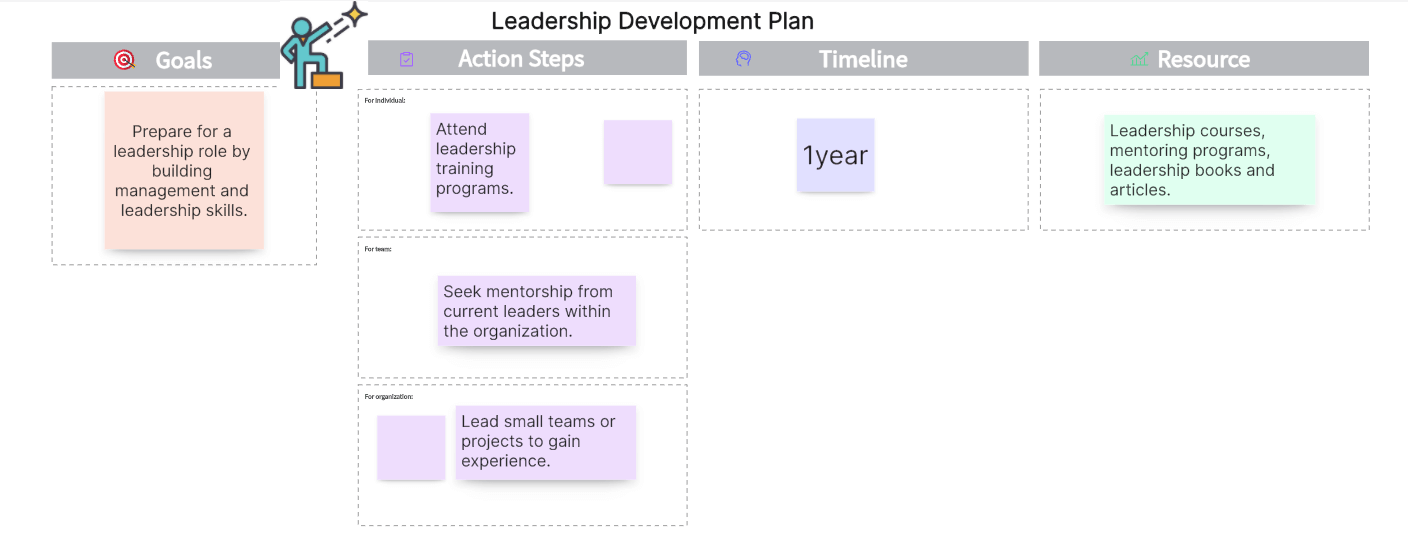
Goal: Prepare for a leadership role by building management and leadership skills.
Action Steps:
- Attend leadership training programs.
- Seek mentorship from current leaders within the organization.
- Lead small teams or projects to gain experience.
Timeline: 1 year
Resources: Leadership courses, mentoring programs, leadership books and articles.
3. Career Transition Plan
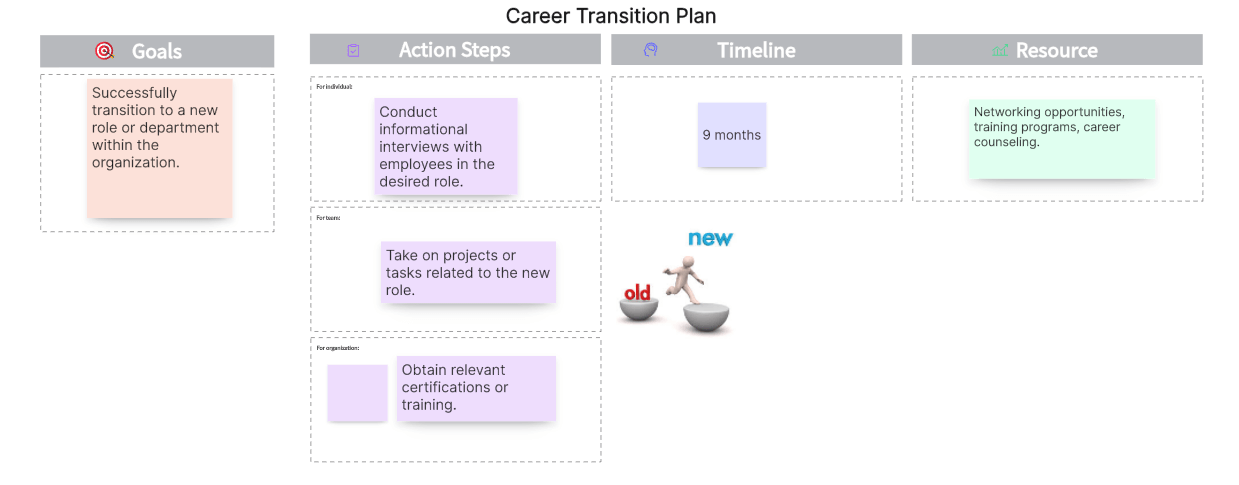
Goal: Successfully transition to a new role or department within the organization.
Action Steps:
- Conduct informational interviews with employees in the desired role.
- Take on projects or tasks related to the new role.
- Obtain relevant certifications or training.
Timeline: 9 months
Resources: Networking opportunities, training programs, career counseling.
4. Performance Improvement Plan

Goal: Improve performance in specific areas identified through feedback or performance reviews.
Action Steps:
- Identify performance gaps and set specific improvement targets.
- Develop a plan with actionable steps to address each target.
- Regularly review progress with a supervisor.
Timeline: 6 months
Resources: Performance review data, feedback from colleagues, and coaching sessions.
5. Project Management Development Plan
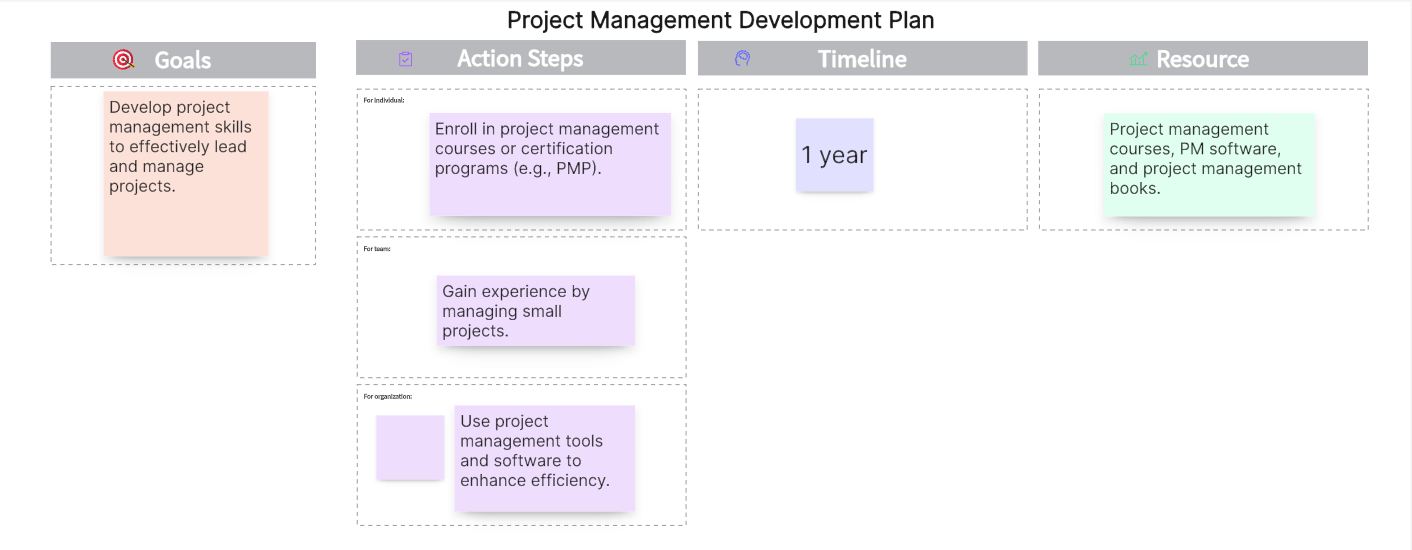
Goal: Develop project management skills to effectively lead and manage projects.
Action Steps:
- Enroll in project management courses or certification programs (e.g., PMP).
- Gain experience by managing small projects.
- Use project management tools and software to enhance efficiency.
Timeline: 1 year
Resources: Project management courses, PM software, and project management books.
6. Sales Skills Development Plan

Goal: Enhance sales techniques and strategies to increase sales performance.
Action Steps:
- Attend sales training workshops or seminars.
- Shadow top-performing salespeople to learn best practices.
- Practice and refine sales pitches and closing techniques.
Timeline: 6 months
Resources: Sales training programs, mentorship, sales books, and articles.
7. Customer Service Development Plan
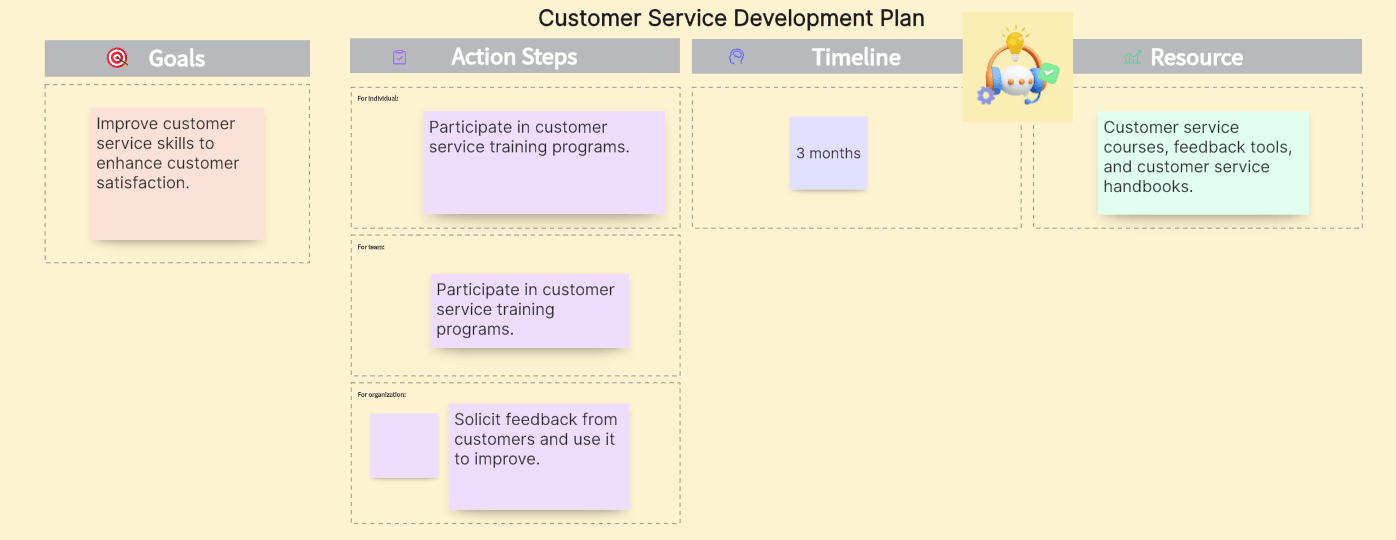
Goal: Improve customer service skills to enhance customer satisfaction.
Action Steps:
- Participate in customer service training programs.
- Role-play customer service scenarios to practice responses.
- Solicit feedback from customers and use it to improve.
Timeline: 3 months
Resources: Customer service courses, feedback tools, and customer service handbooks.
8. Digital Marketing Development Plan

Goal: Build expertise in digital marketing strategies and tools.
Action Steps:
- Take online courses in SEO, social media marketing, and content marketing.
- Implement digital marketing campaigns and analyze their performance.
- Stay updated with the latest digital marketing trends.
Timeline: 1 year
Resources: Online marketing courses, marketing tools, industry blogs, and publications.
9. Soft Skills Development Plan
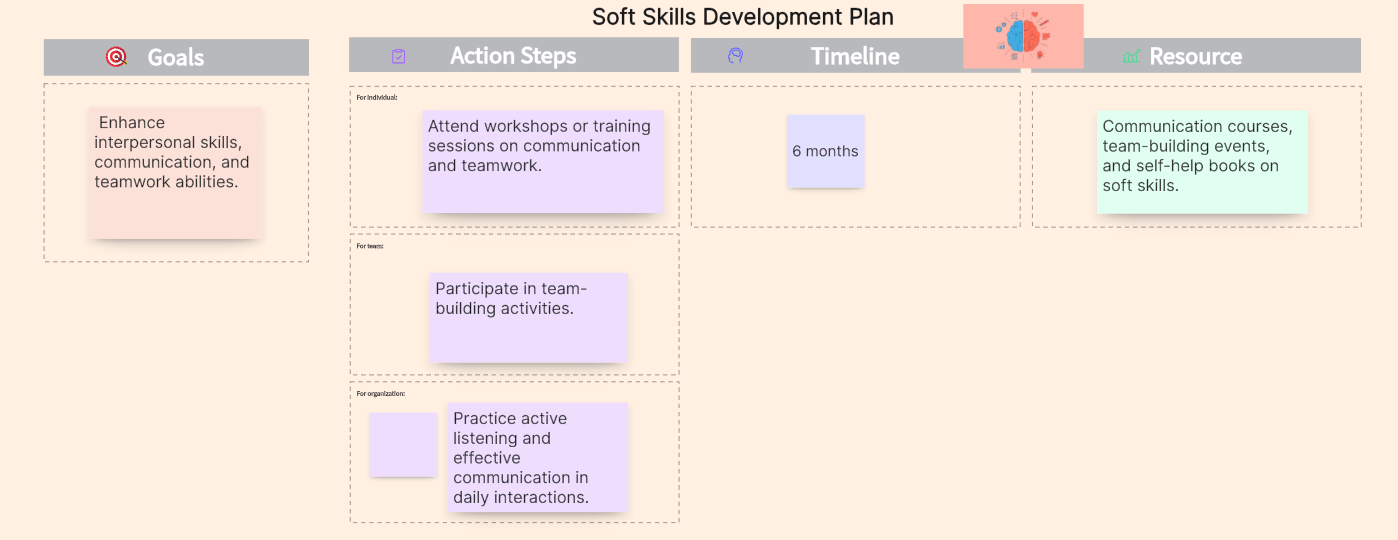
Goal: Enhance interpersonal skills, communication, and teamwork abilities.
Action Steps:
- Attend workshops or training sessions on communication and teamwork.
- Participate in team-building activities.
- Practice active listening and effective communication in daily interactions.
Timeline: 6 months
Resources: Communication courses, team-building events, and self-help books on soft skills.
10. Industry Knowledge Development Plan

Goal: Stay current with the latest trends and developments in the industry.
Action Steps:
- Subscribe to industry publications and newsletters.
- Attend industry conferences and networking events.
- Participate in professional associations and forums.
Timeline: Ongoing
Resources: Industry journals, professional networks, online forums, and discussion groups.
These examples provide a diverse range of development plans tailored to various professional needs, helping employees and employers create actionable and effective IDPs.
How to Create an Individual Development Plan?
Creating an effective Individual Development Plan involves several key steps:
Self-Assessment: The first step is for the employee to conduct a self-assessment to identify their strengths, weaknesses, and career aspirations. This can be done through self-reflection, feedback from colleagues, or formal assessment tools.
Set Clear Goals: Based on the self-assessment, the employee and supervisor should collaboratively set clear, measurable goals. These goals should align with both the employee's career aspirations and the organization's needs.
Identify Required Skills and Knowledge: Determine the skills and knowledge needed to achieve the set goals. This may include technical skills, leadership abilities, industry knowledge, or other competencies.
Develop Action Plans: Create detailed action plans outlining the steps needed to acquire the identified skills and knowledge. This might involve training programs, workshops, on-the-job experiences, or mentorship opportunities.
Allocate Resources: Ensure that the necessary resources, such as time, budget, and support, are allocated to implement the action plans.
Set Timelines: Establish realistic timelines for achieving the goals. This helps keep the employee accountable and ensures steady progress.
Monitor Progress: Regularly review and adjust the IDP as needed. Both the employee and supervisor should monitor progress, provide feedback, and make any necessary adjustments to the plan.
Evaluate and Reflect: Upon completion of the IDP, evaluate the outcomes and reflect on the process. Discuss what was successful, what could be improved, and how the experience has contributed to the employee's development.
By following these steps, employees can create a comprehensive and actionable Individual Development Plan that supports their professional growth and aligns with organizational goals.
Create an Individual Development Plan in Boardmix:
Boardmix is a versatile tool that facilitates the creation of detailed and visually appealing Individual Development Plans (IDPs). Here's a step-by-step guide to help you create an IDP using Boardmix:
Step 1: Create a New Board
Once logged in, create a new board by clicking on the "Create New Board" button on your dashboard.
Step 2: Choose a Template or Start from Scratch
Boardmix offers various templates that can serve as a starting point for your IDP. Search for "Individual Development Plan" templates, or you can start from scratch by selecting a blank board.

Step 3: Define the Structure of Your IDP
- Title and Basic Information: At the top of the board, add a title for your IDP and include basic information such as the employee's name, position, department, and the date the plan was created.
- Sections to Include:
-
- Self-Assessment: Create a section where the employee can list their strengths, weaknesses, opportunities for growth, and areas for improvement.
- Development Goals: Add a section for setting clear, measurable development goals. Each goal should be specific, measurable, achievable, relevant, and time-bound (SMART).
- Action Plan: Outline the steps needed to achieve each goal. This can include training programs, workshops, on-the-job experiences, and other activities.
- Resources Needed: Identify the resources required to accomplish each action step, such as time, budget, training materials, and mentorship.
Step 4: Populate the IDP with Content
- Self-Assessment: Encourage the employee to reflect on their current skills, strengths, areas for improvement, and career aspirations. This can be done through text boxes or sticky notes on the board.
- Development Goals: Work with the employee to define SMART goals. Use shapes or text boxes to clearly outline each goal.
- Resources Needed: List all necessary resources. You can use icons, images, or text to make this section more engaging.
- Timeline: Create a timeline or Gantt chart to map out the completion dates for each action step and goal.
Step 5: Collaborate and Review
Collaboration: Invite the employee, their supervisor, and any other relevant stakeholders to collaborate on the board. Boardmix allows real-time collaboration, so everyone can contribute to and review the plan simultaneously.
Review Meetings: Schedule regular review meetings to discuss progress, provide feedback, and make necessary adjustments to the IDP. Use the progress tracking section to guide these discussions.
By following these steps and using this template as a guide, you can create an effective and visually engaging Individual Development Plan in Boardmix. This approach not only enhances the clarity and organization of the plan but also fosters collaboration and accountability, ensuring successful implementation and continuous employee growth.
In conclusion, Individual Development Plans are not just a pathway for personal growth but a strategic asset for organizational success. By investing in the development of your employees, you foster a culture of continuous improvement, engagement, and loyalty. Whether you are an employee eager to climb the career ladder or an employer aiming to nurture talent within your organization, the IDP is your blueprint for achieving these goals. Embrace the power of IDPs to unlock potential, drive performance, and pave the way for a brighter, more successful future for all.








